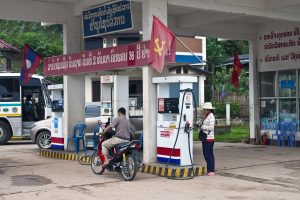Motorists in the Lao capital Vientiane have been forced to queue for hours at petrol stations as a fuel crisis tightens its grip, the latest sign in a brewing economic crisis in the nation of 7 million.
According to a report in the Laotian Times, crisis comes as the country’s COVID-19-hit economy has been buffeted by the impacts of rising global oil prices and a weakening local currency. The resulting fuel shortages have been seen in provincial areas for weeks, but arrived in the capital on Monday afternoon, causing motorists to line up for hours to fill their tanks, snarling traffic along major thoroughfares. According to a report by AFP, petrol stations are limiting customers to a maximum 500,000 kips (around $40) worth of fuel.
As a result of these factors, the Laotian Times reported, state importers say that they are only currently able to import around 20 million liters of the 120 million liters of fuel that the country needs each month. The report cited a letter issued to retailers this week by the Lao State Fuel Company, informing its resellers that it had reached a point where it could “no longer meet the demand of its customers.”
The news came a day after the country’s National Assembly passed a resolution to reduce the excise tax on fuels in order to attempt to avert a fuel crisis in the country. The measure dropped the excise tax on diesel fuels from 21 percent to 11 percent, while excise tax on gasoline will see a drop from 31 percent to 16 percent. The government has also called upon the public to make every attempt to cut back on petrol use, by using public transport, carpooling, or traveling less frequently.
The brewing crisis hints at the perfect storm of economic challenges facing Laos’ $19 billion economy. The Lao kip has dropped considerably in value since September, inflating from 9,370 kip to the U.S. dollar on September 8 to 12,760 kip as of yesterday, at the same time as the global price of oil has soared due to the war in Ukraine.
This comes against a backdrop of the economic impacts of the COVID-19 pandemic, which has over the past two years drained the country’s foreign reserves and produced an incipient foreign debt crisis. The country currently has $13.3 billion in sovereign debt, much of which has financed the construction of large-scale infrastructure projects, many of them part of China’s Belt and Road Initiative (BRI). Among them are the $5.9 billion Laos-China Railway, which opened in December and on which the Lao government has a debt liability of around $1.54 billion.
Economists have long warned that Laos’ foreign debt was on an unsustainable path. In a 2018 report, the Washington-based Center for Global Development concluded that Laos was the one Southeast Asian country risking significant debt distress as a result of BRI loans from Chinese state banks. But the onset of the COVID-19 pandemic in early 2020 has pushed the country into the crisis zone.
In August of that year, global credit agency Moody’s downgraded Laos’ credit rating to junk status, citing “heightened government liquidity risks.” The following month Fitch followed suit, expressing its concern about the government’s “deepening external liquidity pressures as a result of the coronavirus shock and the sovereign’s large debt maturities.” As Fitch then noted, the country owed $1.1 billion in repayments from 2021-24, compared to its current foreign exchange reserves of $1.3 billion. The same month, Laos announced that it ceded majority control of its national power grid to a state-owned Chinese company, citing its low foreign reserves.
In December 2021, the state-run Vientiane Times carried a candid report in which Finance Minister Bounchon Oubonpaseuth told the Lao National Assembly that the government urgently needs 18.7 trillion kip ($1.8 billion) in order “to address the projected fiscal deficit and repay domestic and overseas loans by the end of the year.”
Laos figures among the economic crises that are likely to hit the Global South as fuel and commodity prices continue to rise and the U.S. Federal Reserve hikes interest rates, pushing up the value of the U.S. dollar and increasing the debt burden on many developing countries. With limited options for restructuring or rolling over its debt, the country is very likely heading into deeper crisis in the weeks and months to come.

































